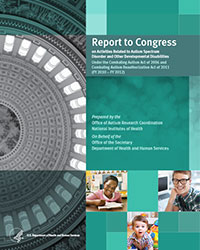Report to Congress
On Activities Related to Autism Spectrum Disorder and Other Developmental Disabilities
FY 2010 - FY 2012
The current Interagency Autism Coordinating Committee (IACC) was established by Congress under the Combating Autism Act (CAA; P.L. 109-416, PDF - 142 KB) and reauthorized in 2011 under the Combating Autism Reauthorization Act (CARA; P.L. 112-32, PDF - 121 KB) to provide advice to the Secretary of Health and Human Services (HHS) concerning issues related to autism spectrum disorder (ASD) and to coordinate all ASD-related efforts within HHS. Read more.
Required Elements of the Report to Congress
In addition to a summary of the role of the Interagency Autism Coordinating Committee and NIH Office of Autism Research Coordination in coordinating ASD efforts, this Report to Congress overviews each federal agency that supports projects or programs related to ASD, as well as highlights information on current ASD incidence estimates, the present diagnostic and intervention landscape, ongoing efforts in ASD supports and services, and strategies to address the continuing needs of diverse ASD communities. Read more.
This chapter covers subsections (1) and (2) of Section 399DD of the CAA, which require: (1) "A description of the progress made in implementing the provisions of the Combating Autism Act of 2006", and (2) "A description of the amounts expended on the implementation of the particular provisions of the Combating Autism Act of 2006." In accordance with the statute, details are provided from the agencies and offices within HHS that are involved in ASD research and services activities, including ACF, ACL, AHRQ, CDC, CMS, FDA, HRSA, NIH, and SAMHSA, as well as the Department of Education (ED), Environmental Protection Agency (EPA), Department of Defense (DoD), and National Science Foundation (NSF), which also conduct activities that concern or are related to ASD. Read more.
Prevalence of Autism Spectrum Disorder
The CDC surveillance efforts reported in this chapter provide current ASD prevalence information rather than incidence. Incidence measures are typically more limited and indicate the number of newly diagnosed people with a disorder during a specific time period. In comparison, prevalence data indicate the total number of people affected at any given time in the population studied. Given the variability in the age of diagnosis of ASD and that not all children identified by the CDC surveillance efforts have a documented diagnosis, capturing prevalence, rather than incidence, is a more complete method for estimating the impact of ASDs in the population. Read more.
This section addresses Subsection (4) of 399DD: "Information on the average age of diagnosis for children with ASD and other developmental disabilities, including how that age may have changed over the 4-year period beginning on the date of enactment for this Act." Information on the average age of diagnosis for individuals with ASD is provided by the CDC and HRSA. Read more.
This section addresses subsection (5) of 399DD: "Information on the average age for intervention for individuals diagnosed with ASD and other developmental disabilities, including how that age may have changed over the 4-year period beginning on the date of enactment of this Act." Information on the average age of intervention for individuals with ASD is provided by the CDC. Read more.
Average Time Between Screening, Diagnosis, and Intervention
This section addresses section (6) of 399DD: "Information on the average time between initial screening and then diagnosis or rule out for individuals with ASD or other developmental disabilities, as well as information on the average time between diagnosis and evidence-based intervention for individuals with ASD or other developmental disabilities." Information on the average time between screening, diagnosis, and intervention for individuals with ASD is provided by the CDC. Read more.
Effectiveness and Outcomes of Interventions
This section addresses subsections (7) and (8) of 399DD, which require: (7) "Information on the effectiveness and outcomes of interventions for individuals diagnosed with autism spectrum disorder, including by various subtypes, and other developmental disabilities and how the age of the child may affect such effectiveness," and (8) "Information on the effectiveness and outcomes of innovative and newly developed intervention strategies for individuals with autism spectrum disorder or other developmental disabilities." Information on the effectiveness and outcomes of interventions is provided by AHRQ, CMS, ED, DoD, HRSA, NIH, and SAMHSA. Read more.
This section addresses subsection (9) of 399DD: "Information on services and supports provided to individuals with autism spectrum disorder and other developmental disabilities who have reached the age of majority (as defined for purposes of section 615(m) of the Individuals with Disabilities Education Act (20 U.S.C. 1415(m))." Information on ASD adult services and supports is provided AHRQ, CMS, ED, DoD, HRSA, NIH, and SAMHSA. Read more.
Since the enactment of the Combating Autism Act in 2006, and its reauthorization under the Combating Autism Reauthorization Act of 2011, federal agencies, in partnership with the community, have made significant strides in addressing many of the pressing needs of individuals and families affected by autism spectrum disorder. In the period covered by this report, from 2010-2013, federally-funded programs and projects have increased knowledge about how prevalent ASD is in the U.S. population and how early in life ASD can be detected. Read more.




